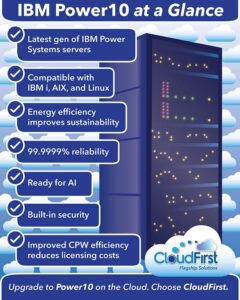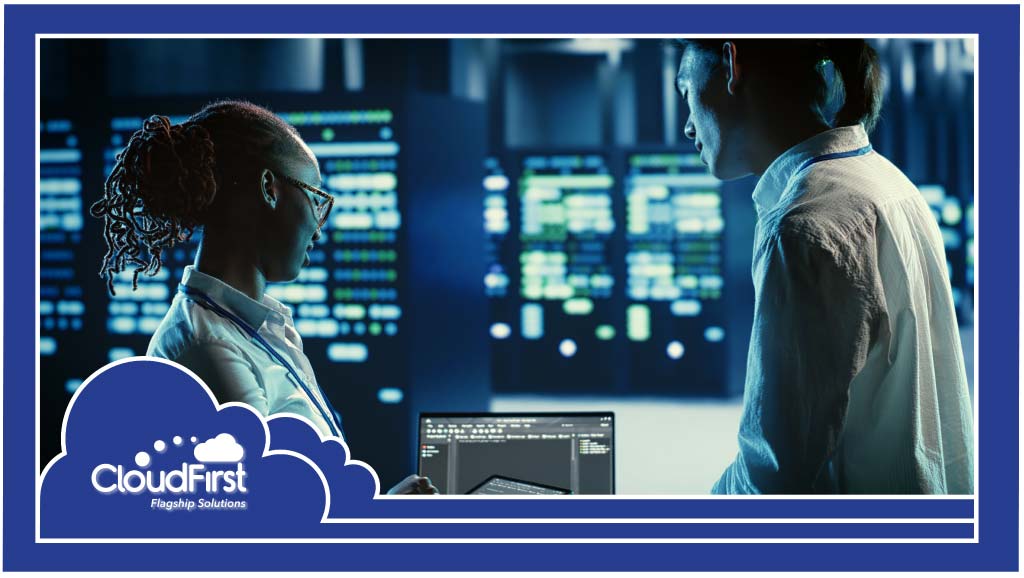Are you ready to make the change and upgrade to IBM Power10?
You’re tired of feeling like your systems aren’t performing up to your standard. You’ve heard about the security benefits of Power10 and the ability to scale for future growth. But no matter how prepared you are to make the change, the shift can feel like a monumental task if you’re accustomed to your current IT setup.
Even if it feels scary, you can take solace in knowing you’re headed in the right direction. Neil Cumins for Business News Daily writes: “Businesses are only as efficient as their infrastructure. When it comes to technology, holding on to old or inefficient business software and hardware can have profound ramifications.”
Essentially, if you continue to use end-of-life (EOL) systems like Power8, your business will remain in the past and be unable to grow to its full potential.
But what does a healthy transition to IBM Power10 actually look like? Here are seven steps to prepare and execute your upgrade to Power 10 to reap the benefits and minimize risk.
1. Assess the need for an upgrade
Before taking any other steps, you need to clearly explain why an upgrade to Power10 is beneficial for your organization.
Don’t just make assumptions. Make a business case and write it down.
Is extended support for older systems costing more and more as time goes on? Are security vulnerabilities putting your entire organization at risk of ransomware attacks or data breaches?
Upgrading to Power10 can effectively address these issues. However, you should also understand how well your company will be able to tolerate downtime and minimize the impact of the transition.
Additionally, you may need to make provisions for moving from on-prem to the cloud.
2. Discuss the business case for upgrading with executive stakeholders
Once you clearly understand the benefits of an upgrade, open up the conversation with other leaders in your business.
Involve key stakeholders, including executives and department heads, early in the planning process. Make sure to involve everyone who an upgrade impacts, from end users to IT directors to business decision-makers.
Hold executive meetings to discuss the benefits of upgrading to Power10 and set clear expectations. Address potential concerns, such as downtime and costs.
This will enable you to develop a comprehensive plan that outlines the upgrade timeline and milestones, easing stakeholders’ worries and showing a clear path to return on investment.
3. Involve your network team from the beginning

Your network team plays a crucial role in the upgrade process because, ultimately, they’ll be the ones ultimately managing the transition.
Engage them from the start. This ensures they understand the technical requirements and are ready for any challenges. Collaboration between the network team and other departments is essential to ensure a seamless transition.
4. Contact vendors
Begin discussions with your vendors, including those providing software and managed services. Check their offerings and determine if their products and services will transition to Power10. You may also incur upgrade fees when moving to Power10, so starting early is better.
5. Check compatibility
Before upgrading, ensure that your current applications are compatible with Power10. Conduct thorough testing and work closely with your software vendors to address any compatibility issues.
This is one of the most crucial steps that IBM officially recommends; checking compatibility can help avoid disruptions and ensure that all applications function smoothly post-upgrade. It can also inform you of any other upgrades your systems might need.
For example, if you realize you’ll need more power supply once the transition is complete, you can plan ahead for that and have it ready.
6. Plan for post-upgrade changes

How will your business extract maximum value from your new Power10 systems? It’s time to get clear about that. However, it’s smart to work through your to-do list incrementally in order to minimize risk.
Once the upgrade is complete, you’ll likely be implementing many other changes. For example, you may want to upgrade to the latest version of IBM i, but it’s best to wait until after the hardware upgrade to perform an operating system (OS) version change.
Upgrading the hardware first allows you to stabilize your new environment before making additional changes. This approach minimizes the risk of errors and ensures a more controlled transition.
You may want to consider more upgrades or enhancements to further improve your IT infrastructure. For instance, explore advanced security features or cloud solutions with added benefits that gel nicely with Power10’s features.
7. Find a trusted partner
There’s no sugarcoating it: even if upgrading offers massive benefits, you’re still upending your IT systems and processes.
You want a partner who can provide peace of mind. They should help you avoid confusion and frustration. Better yet, they should also support you with resources to navigate the transition.
CloudFirst is a partner that provides reliable cloud solutions and managed services, ensuring a hassle-free upgrade to Power10. This will be extremely beneficial as you move data and applications safely during the transition.
We can also help you take your IT infrastructure upgrade one step further by simultaneously moving you from an in-house deployment to a cloud hosting solution.
How do you know if you’re ready for an upgrade to Power10?

The first step is to determine whether an upgrade is right for your business. If you’re still unsure, ask yourself these questions:
- Are my current systems meeting my business needs?
- Is my company experiencing frequent downtimes or performance bottlenecks?
- Is our IT system outdated and frustrating for the IT and network teams?
- Does IBM still support the technology we use?
- Is our cybersecurity at risk because of unpatched vulnerabilities?
If you weren’t happy with the answer to any of these, your business would benefit from upgrading to Power10.
Ultimately, for many businesses, it all comes down to what your team really needs, as they’ll be dealing with the brunt of the changes. As Solomon Thimothy writes for Forbes, “Always check in with your team before you decide to upgrade or replace something.” This is the foundation for creating alignment.
How do you make sure everyone is on the same page?
Change can be hard, even if the current system is significantly less efficient than it could be. It’s up to you to keep everyone on the same page and on board with the transition. Here’s how to make that easier on yourself
Hold meetings about the upgrade to Power10
Schedule regular meetings with leaders from the business, IT, and networking teams. Discuss progress and address concerns. This will give you valuable insight into how the company feels about the changes and provide guidance on moving forward.
Develop a communication plan
Create a holistic communication plan. It should outline the upgrade timeline, key milestones, and roles. Share this plan with all stakeholders to keep everyone informed and engaged. A clear communication plan will build trust and give you an opportunity to hear concerns or comments.
Offer training sessions
Training your employees on new systems is always important. Ottawa University says that training and development “helps employees establish a sense of value within the company and fosters loyalty, ultimately resulting in increased staff retention and a 59% lower staff turnover rate.”
Training ensures a smooth transition to Power10 and reduces potential disruptions. Without a way for employees to fully grasp how their jobs will be affected, they’ll feel lost and frustrated, and they’ll be much more likely to resent the change.
Powering your future with IBM Power 10
Upgrading to Power10 is a smart move. It can boost your organization’s performance, security, and cost efficiency.
To learn how our IBM Power Systems cloud solutions can support your upgrade, contact us today. Let us be your trusted partner in this critical transition, and we’ll guarantee our full support every step of the way.

